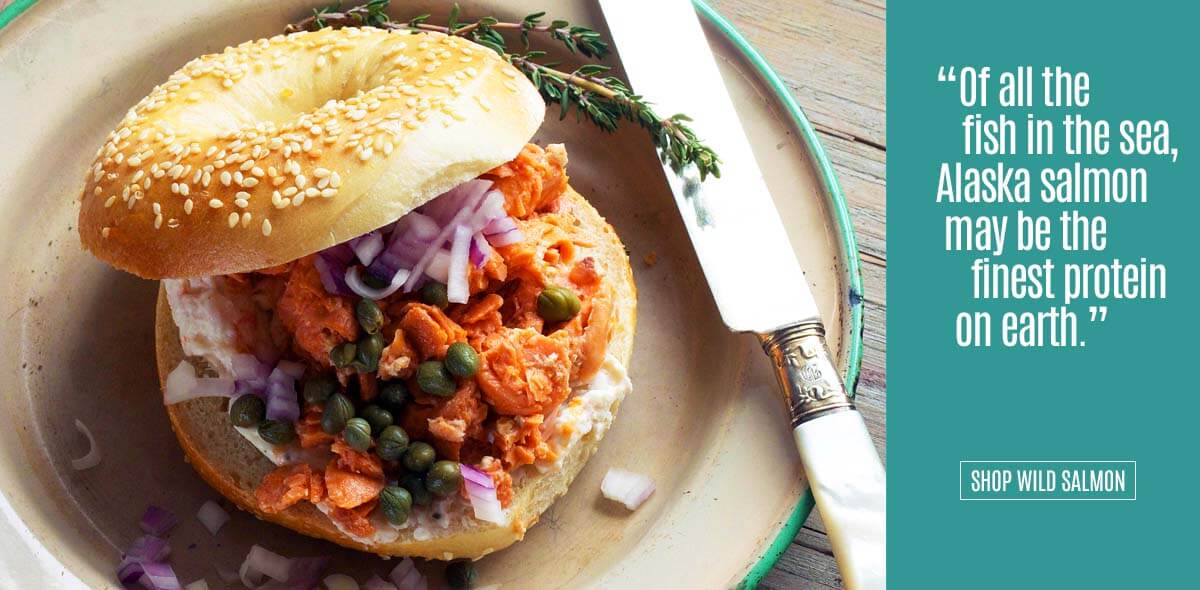Health and Nutrition
Highest Omega-3s
Wild Alaska salmon are some of the richest sources of long-chain Omega-3 fatty acids. The human body cannot manufacture it’s own Omega-3s, so it is from food that we must obtain them. Omega-3s are thought to provide substantial health benefits for people of all ages; providing a nutritional foundation for optimal heart, brain, mental, visual, immune system and pregnancy health. Cold water fatty fish, such as salmon, which are particularly rich in Omega-3 fatty acids, was the first food ever endorsed by the American Heart Association. For more information see Alaska Seafood’s The Benefits and Are Fish and Plant Omega-3s the Same? (PDF).
Nutritional Comparison Charts
Omega-3 Fatty Acids (mg)
Calcium (mg)
Vitamin E (IU)
Highest Vitamin D
Vitamin D is naturally present in very few foods and wild Alaska salmon, especially sockeye salmon (but pink is no slouch either) is one of the richest sources of Vitamin D.
The flesh of certain fish, such as salmon, and fish liver oils are among the best sources. Small amounts of vitamin D are found in beef liver, cheese, and egg yolks.
Vitamin D promotes calcium absorption, maintenance of healthy bones and the optimal function of the neuromuscular and immune systems. It is also thought to reduce inflammation in the body.
Wild salmon is arguably the most delicious source of Vitamin D, and canned wild Alaska salmon is the most consistent and reliable way of keeping wild salmon in your diet, year around.
Here is a quick comparison chart, with data supplied by the USDA:
Vitamin D (IU)
Low/No Mercury
People of all ages and stages, including pregnant moms and babies can eat Alaska salmon unlimitedly because there is so little mercury, if any, in Alaska salmon.
Three factors contribute to Alaska wild salmon’s remarkable purity:
- Wild Alaska salmon are short-lived fish that feed very “low” on the food chain. Pink and red salmon live only two to four years, respectively.
- Wild salmon are filter feeders, not predatory fish.
- Environment is everything! Wild Alaska salmon inhabit the pristine waters of the North Pacific and its surrounding landmass, an area millions of miles square that suffers little to no industrial pollution.
The State of Alaska has an extensive fish monitoring program. The United States Environmental Protection Agency and the Food and Drug Administration have set the bar at 1 parts per million for mercury in the flesh of fish as a ‘safe’ level. Canada and Japan have set the bar at half that, or .5 parts per million. Alaska salmon have less than .05 parts per million, or 20 times less than the lowest level of concern for the U.S. or 10 times less than the lowest level of concern for the more stringent standards set by Canada or Japan:
Amount of Mercury Allowed in the Flesh of Fish
For more information see:
- State of Alaska Epidemiology Bulletin Newsletter: Fish Consumption Advice for Alaskans: A Risk Management Strategy to Optimize the Public’s Health (PDF)
- Alaska Department of Health and Social Services Fish Facts & Consumption Guidelines
Special Note for Pregnant & New Moms & Babes
Fish, particularly cold water fatty fish such as Alaska salmon, are an especially fine food choice for expectant or new moms and their babies.
Rich in long chain omega 3 fatty acids, iodine, selenium and Vitamin D, cold water fish are uniquely endowed with a constellation of nutrients critical for optimal brain and neurological development in babies.
Optimal nutrition is important during the fetal stage and in the crucial two years after birth, when a baby’s brain continues to grow. Studies have shown that higher seafood consumption in mothers is correlated with greater intellectual abilities, better social skills and more physical advancement in their offspring.
In addition, there is some scientific evidence that adequate consumption of long chain omega-3’s reduces the incidence of post partum depression in new mothers. This old wife thinks that eating canned Alaska salmon at lunch significantly helped her with post partum depression, along with exercising.
With negligible to no methyl mercury or other any other contaminants, new and pregnant moms and their year old infants can enjoy Alaska salmon with confidence.
For more information see:
- Alaska Seafood’s Healthy Mother, Healthy Baby publication (PDF)
- Alaska Seafood’s The Benefits

